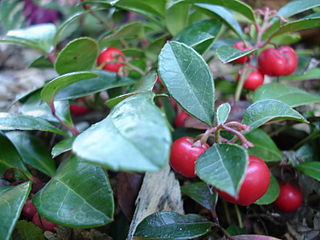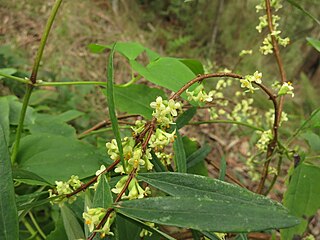
Gaultheria procumbens, also called the eastern teaberry, the checkerberry, the boxberry, or the American wintergreen, is a species of Gaultheria native to northeastern North America from Newfoundland west to southeastern Manitoba, and south to Alabama. It is a member of the Ericaceae.

Oxyria digyna is a species of flowering plant in the buckwheat family (Polygonaceae). It is native to arctic regions and mountainous parts of the Northern Hemisphere.

Arctous alpina, with the common names alpine bearberry, mountain bearberry, or black bearberry is a dwarf shrub in the heather family Ericaceae. The basionym of this species is Arbutus alpina L..

Exocarpos cupressiformis, with common names that include native cherry, cherry ballart, and cypress cherry, belongs to the sandalwood family of plants. It is a species endemic to Australia. Occasionally the genus name is spelt "Exocarpus" but it appears to be mostly no longer in use.

Hakea archaeoides is a large shrub or small tree commonly known as Big Nellie hakea and is endemic to forest areas on the north coast of New South Wales, Australia. It has clusters of red and greenish yellow flowers in the flowering season.

Gaultheria hispida, commonly known as the copperleaf snowberry, is an endemic eudicot of Tasmania, Australia. It is an erect multi-branched shrub, that can be found in wet forests and alpine woodlands. Its berries appear snowy white and leaves are tipped with a copper tinge, hence the common name.

Bellendena montana, commonly known as mountain rocket, is a species of low-growing multi-stemmed shrub in the plant family Proteaceae. It is endemic to high-altitude subalpine and alpine regions in Tasmania, Australia. The prominent white flower spikes appear over summer, followed by small bright red or yellow fruit in late summer and autumn.

Exocarpos strictus, with common names pale-fruit ballart, pale ballart, and dwarf cherry, is an adaptably versatile erect shrub bearing cherry-like fruit, that forms dense thickets, that is native to parts of Australia. E. strictus was described by botanist Robert Brown in 1810.
Archeria comberi, also known as the pink mountain heath or comb heath, is a small, rare shrub endemic to Tasmania, Australia. As a member of the heath family, Ericaceae, this species is generally classified as a subalpine/ alpine species and shares many characteristics with other members of the family. It is an evergreen shrub 0.15m-1m in height, with pink flowers during the summer months, hence its common name pink mountain heath. Archeria comberi is often found growing among other species such as Nothofagus gunnii and Persoonia gunnii.

Orites revolutus , also known as narrow-leaf orites, is a Tasmanian endemic plant species in the family Proteaceae. Scottish botanist Robert Brown formally described the species in Transactions of the Linnean Society of London in 1810 from a specimen collected at Lake St Clair. Abundant in alpine and subalpine heath, it is a small to medium shrub 0.5 to 1.5 m tall, with relatively small, blunt leaves with strongly revolute margins. The white flowers grow on terminal spikes during summer. Being proteaceaous, O. revolutus is likely to provide a substantial food source for nectivorous animal species within its range.

Hakea microcarpa , commonly known as small-fruit hakea is a flowering plant in the family Proteaceae and is endemic to eastern Australia. It is a spreading shrub, often growing in woodlands, heathlands and near swamps in montane areas of eastern Australia.

Cenarrhenes is a monytypic genus in the family Proteaceae containing the single species Cenarrhenes nitida, known as the Port Arthur plum or native plum. Cenarrhenes nitida is an evergreen shrub to small tree endemic to the rainforests and scrublands of western Tasmania. It bears white flowers in late spring followed by the development of fleshy fruit.

Exocarpos latifolius is a species of parasitic trees, of the plant family Santalaceae. They have the common names broad leaved ballart, scrub sandal-wood, scrub cherry, oringorin, broad leaved cherry or native cherry. The species is found in monsoon forest, littoral rainforest and occasionally in more open forest types in Malesia and across Northern Australia.
Exocarpos homalocladus, commonly known as the grass tree, is a flowering plant in the sandalwood family. The specific epithet comes from the Greek homalos (“flat”) and clados, with reference to the structure of the plant.

The flora of the U.S. Sierra Nevada alpine zone is characterized by small, low growing, cushion and mat forming plants that can survive the harsh conditions in the high-altitude alpine zone above the timber line. These flora often occur in alpine fell-fields. The Sierra Nevada alpine zone lacks a dominant plant species that characterizes it, so may or may not be called a vegetation type. But it is found above the subalpine forest, which is the highest in a succession of recognized vegetation types at increasing elevations.

Hakea lissosperma, commonly known as needle bush and mountain needlewood, is a species of Hakea native to parts of south eastern Australia.
Hakea vittata, commonly known as the striped hakea, hooked needlewood, is a shrub of the family Proteaceae. Restricted to an area on the Eyre Peninsula and the Gawler Range in South Australia and small areas in eastern Victoria.

Baeckea gunniana, commonly known as alpine baeckea, is a species of a compact, densely branched evergreen shrub, growing in alpine and sub-alpine Australia. Baeckea is a genus of flowering plants in the myrtle family, Myrtaceae, comprising 14 species occurring in eastern Australia and Asia.

Pimelea axiflora, commonly known as bootlace bush, is a small shrub in the family Thymelaeaceae and is endemic to Australia. It is a small shrub with whitish flowers on mostly smooth stems.

Coprosma moorei, commonly known as blue matcurrant or turquoise coprosma, is a small, mat forming, prostrate shrub in the Rubiaceae family. It is native to highland areas of Tasmania and Eastern Victoria.





















